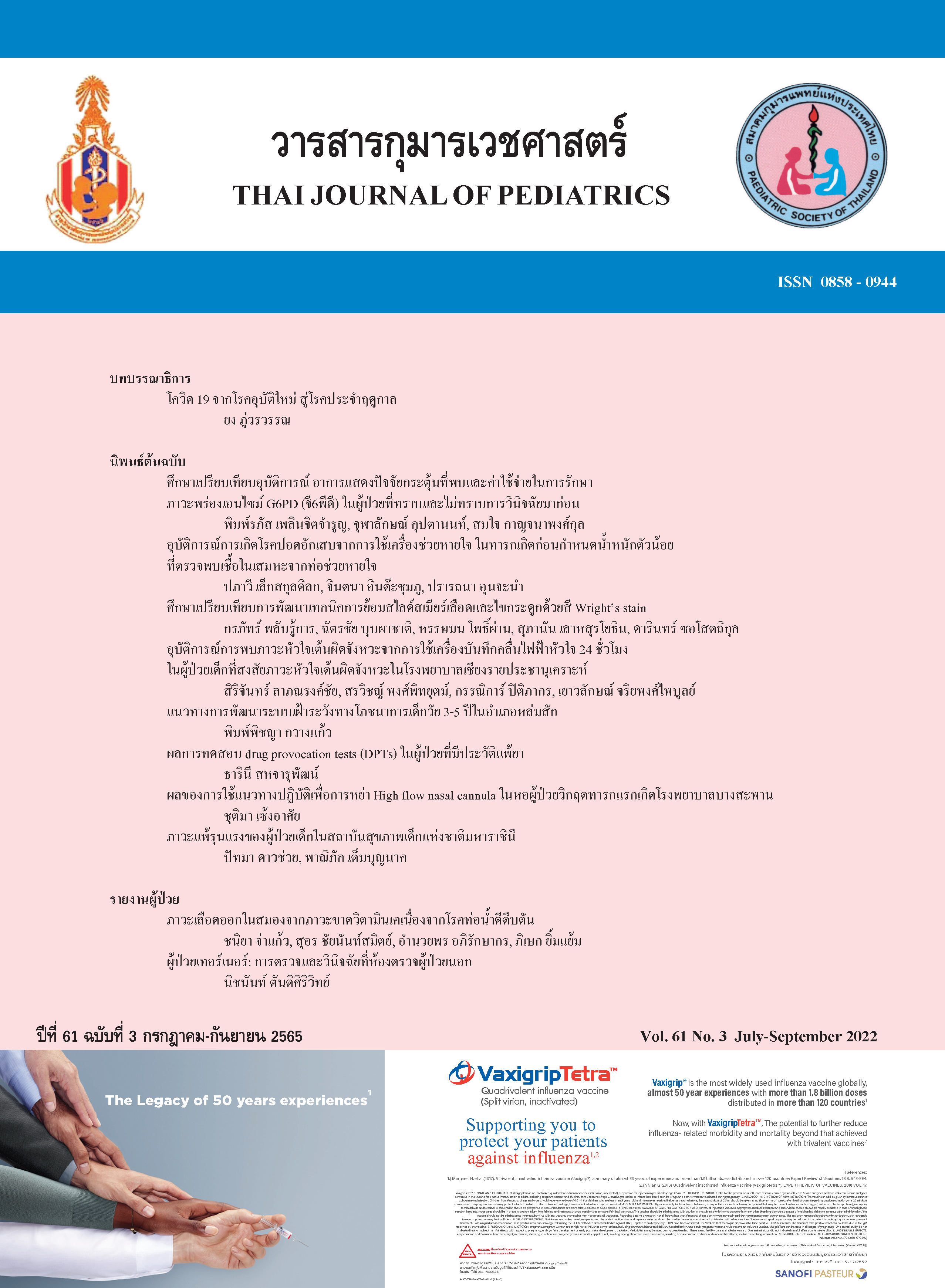ผลการทดสอบ drug provocation tests (DPTs) ในผู้ป่วยที่มีประวัติแพ้ยา
คำสำคัญ:
การแพ้ยา, การทดสอบทางผิวหนัง, การทำ drug provocationtest, ผื่นแพ้บทคัดย่อ
บทนำ: การวินิจฉัยแพ้ยามักอาศัยประวัติโดยไม่มีการประเมินการวินิจฉัยเพิ่มเติม อย่างไรก็ตามหลายการศึกษาระบุว่าการอาศัยประวัติเพียงอย่างเดียวไม่น่าเชื่อถือ แม้ว่าการทำ drug provocation test (DPT) จะเป็นมาตรฐานสำหรับการวินิจฉัย แต่ก็มีรายงานเกี่ยวกับ drug provocation tests (DPTs) น้อยมากในประเทศไทย ดังนั้นผู้วิจัยจึงได้ทำการศึกษาเพื่อนำเสนอผลลัพธ์ของ (DPT) ในผู้ป่วยที่มีประวัติสงสัยว่าแพ้ยา
วัตถุประสงค์ : เพื่อศึกษาอัตราการแพ้ยาจริงในผู้ป่วยที่เกิดผื่นขณะรักษาด้วยยาชนิดต่างๆ
วิธีการศึกษา : เป็นการทบทวนเวชระเบียนข้อนหลังของผู้ป่วยที่สงสัยว่าแพ้ยาระหว่างเดือนพฤศจิกายน 2560 - กันยายน 2563 ที่คลินิกโรคภูมิแพ้ในเด็กโรงพยาบาลมหาราชนครศรีธรรมราชผู้ป่วยทุกรายได้รับการสัมภาษณ์ข้อมูลทางประชากรศาสตร์และประวัติแพ้ยาโดยละเอียด นัดมาทำการทคสอบผิวหนัง โดยใช้ความเข้มข้นยามาตรฐาน และถ้าผลทดสอบทางผิวหนังเป็นลบหรือไม่มีน้ำยามาตรฐานที่ใช้ในการทศสอบต่อยาชนิดนั้นๆ ก็จะทำการทดสอบด้วยการทำ DPTs โดยใช้ขนาดยาที่ปรับตามอายุน้ำหนัก
ผลการศึกษา : ทำการทดสอบผิวหนัง 27 ครั้งและ DPT 43 ครั้งในผู้ป่วย 44 คน (หญิง 27 คน ชาย 17 คน) อายุเฉลี่ยคือ 10 ปี ไม่แพ้ยา 39 คน (88.6%) และมีเพียง 5 คน (11.4% ได้รับการยืนยันว่าแพ้ยาจริง โดย 1 ใน 5 คนที่แพ้ยา (20%) ได้รับการยืนยันโดยการทดสอบทางผิวหนังเป็นบวกต่อยา ceftriaxone ที่เหลืออีก 4 คน (80% ) ได้รับการยืนข้นโดยการทำ DPT และไม่มีผู้ป่วยรายใดเกิดการแพ้ชนิด systemic reaction จากการทดสอบด้วยวิธี skin prick test (SPT) และ intradermal test (IDT) ผู้ป่วย 4 รายที่ได้รับการวินิจฉัยว่าแพ้ยา พบว่าแพ้ยา NSAID (n=1) และ cefotaxine (n=1) โดยเกิดผื่นลมพิษหลังการทดสอบแพ้ยา omeprazole (n=1) เกิดผื่นชนิด fix drug eruption พบว่ามีผู้ป่วยเพียง 1 รายที่เกิดการแพ้รุนแรงชนิด anaphylaxis ต่อยา L-Asparaginase (n=1) โดยได้รับการรักษาอย่างรวดเร็วและตอบสนองดีหลังให้ยา epinephrine เข้ากล้ามเนื้อ และ antihistamine ทางหลอดเลือดดำในทันที ผู้ป่วยรายนี้ปลอดภัยดี
สรุป : หลังการทดสอบแพ้ยาครบพบว่าผู้ป่วยเพียง 5 คน (11.4%) มีภาวะแพ้ยาจริง ดังนั้นการทดสอบทางอิมมูโนวิทยาและขั้นตอนการทำ DPT ในผู้ป่วยที่มีประวัติสงสัยว่าแพ้ยามีความสำคัญทั้งในการสร้างการวินิจฉัยที่ถูกต้องและเพื่อลดการหยุดยาชนิดนั้นๆ โดยไม่จำเป็น
Downloads
เอกสารอ้างอิง
Boguniewicz M, Leung DYM. Adverse reactions to drugs. In: Kliegman RM, Behrman RE, Jenson HB, Stand BF, editors. Nelson textbook of pediatrics. 18th ed. Philadelphia: Saunders Inc.: 2007:990-3.
Demoly P, Pichler W, Pirmohamed M, Romano A. Important questions in Allergy: 1-drug allergy/hypersensitivity. Allergy. 2008; 63:616-9.
DesWarte RD, Patterson R. Drug allergy. In: Patterson R, Grammer LC, GreenbErger PA, editors. Allergic Diseases. 5th ed. Philadelphia: Lippincott-Raven; 1997:317-412.
Ceilic G, Pichler WJ, Adkinson NF Jr. Drug allergy. In:Adkinson NF Jr, Bochner BS, Busse WW, Holgate ST, Lemanske RF Jr, Simons FER, editors. Middleton’s allergy, principles & practice. 7th ed. China: Elsevier Inc.; 2009:1205-26.
Gomes E, Cardoso MF, Praca F, et al. Selfreported drug allergy in a general adult Portuguese population. Clin Exp Allergy2004; 34:1597-601
Solensky R. Drug hypersensitivity. Med Clin North Am 2006; 90: 233–60
Gandhi TK, Weingart SN, Borus J, et al. Adverse drug events in ambulatory care. N Engl J Med 2003; 348:1556-664.
Lazarou J, Pomeranz BH, Corey PN. Incidence of adverse drug reactions in hospitalized patients: a meta-analysis of prospective studies.JAMA1998; 279:1200-5.
Porter J, Jick H. Drug-related deaths among medicalimpatients.JAMA. 1977; 237:879-81.
Jirapongsananuruk O, Bunsawansong W, Piyphanee N, Visitsunthorn N, Thongngarm T, Vichyanond P. Features of patients with
anaphylaxis admitted to a university hospital. Ann Allergy Asthma Immunol. 2007; 98:157-62.
Picard M, Begin P, Bouchard H, et al. Treatment of patients with a history of penicillin allergy in a large tertiary care academic hospital. J Allergy Clin Immunol: In practice 2013; 1:252-7.
MacLaughlin EJ, Saseen JJ, Malone DC. Costs of betalactam allergies selection and costs of antibiotics for patients with a reported betalactam allergy. Arch Fam Med 2009; 9:722-6.
Sade K, HoltzerI,LevoY, et al.The economic burden of antibiotic treatment of penicillin allergic patients in internal medicine wards
of general tertiary care hospital. Clin Exp Allergy 2003; 33:501-6.
Caubet CJ, Kaiser L, Lemaıˆtre B, Fellay B, Gervaix A, Eigenmann AP. The role of penicillin in benign skin rashes in childhood:Aprospective study based on drug rechallenge.J Allergy Clin Immunol 2011;127:218-22.
Hershkovich J, Broides A, Kirjner L, et al. Betalactam allergy and resensitization in children with suspected betalactam allergy.
ClinicalExperimentalAllergy2009;39:726-30.
Park MA, LiJT. Diagnosis and management of penicillin allergy. Mayo Clin Proc. 2005;80:405-10.
Executive summary of disease management of drug hypersensitivity: a practice parameter. Joint Task Force on Practice Parameters, the
American Academy of Allergy, Asthma and Immunology, and the Joint Council of Allergy, Asthma and Immunology. Ann Allergy Immunol 2010; 105:1-78.
Demoly P, Kropf R, Bircher A, et al. Drug hypersensitivity: questionnaire. Allergy 1999; 54: 999-1003.
Sagar PS and Katelaris CH. Utility of penicillin allergy testing in patients presenting with a history of penicillin allergy. Asia Pac Allergy 2013; 3:115-9.
Caubet CJ, Kaiser L, Lemaıˆtre B, Fellay B, Gervaix A, Eigenmann AP. The role of penicillin in benign skin rashes in childhood:Aprospective study based on drug rechallenge.J Allergy Clin Immunol 2011;127:218-22.
Aberer W, Bircher A, Romano A, et al. Drug provocation testing in the diagnosis of drug hypersensitivity reactions: general
considerations. Allergy 2003; 58:85-63.
Bousquet P-J, Gaeta F, Bousquet-Rouanet L, et al. Provocation tests in diagnosing drug hypersensitivity. Curr Pharm Des 2008;
:2792-802.
Romano A, Blanca M, Torres MJ, et al. Diagnosis of nonimmediate reactionsto betalactam antibiotics.Allergy 2004; 59:1153-60.
Blanca M, RomanoA, Torres MJ, Demoly P, DeWeck A. Continued need of appropriate betalactam-derived skin test reagentsfor the
management of allergy to betalactams. Clin Exp Allergy. 2007; 37:166-7.
Brockow K, Romano A. Skin tests in the diagnosis of drug hypersensitivity reactions. Curr Pharm Des 2008; 14:2778-91.
RomanoA,CaubetJC.Antibiotic allergiesin children and adults: from clinical symptom so skin testing diagnosis. J Allergy Clin Immunol Pract. 2014; 2:3-12.
Bousquet PJ, Pipet A, Bousquet-Rouanet L,Demoly P. Oral challenges are needed in the diagnosis of beta-lactam hypersensitivity.
Clin Exp Allergy. 2008; 38:185-90.
ManuyakornW, Singvijarn P, Benjaponpitak S, et al. Skin testing with β-lactam antibiotics for diagnosis of β-lactam hypersensitivity in
children.Asian Pac JAllergy Immunol 2016;34:242-7.
ดาวน์โหลด
เผยแพร่แล้ว
รูปแบบการอ้างอิง
ฉบับ
ประเภทบทความ
สัญญาอนุญาต

อนุญาตภายใต้เงื่อนไข Creative Commons Attribution-NonCommercial-NoDerivatives 4.0 International License.



